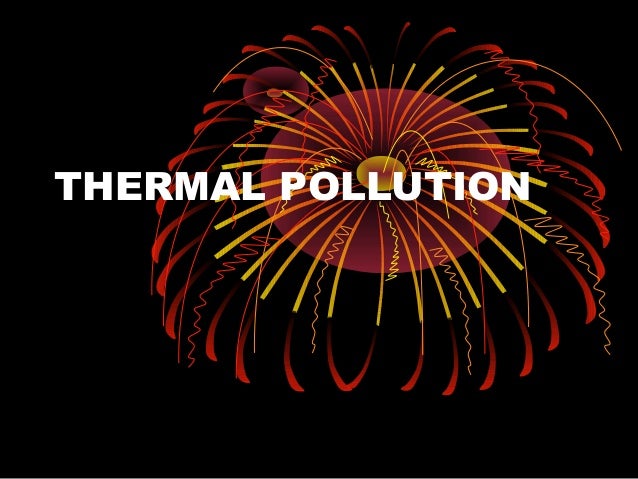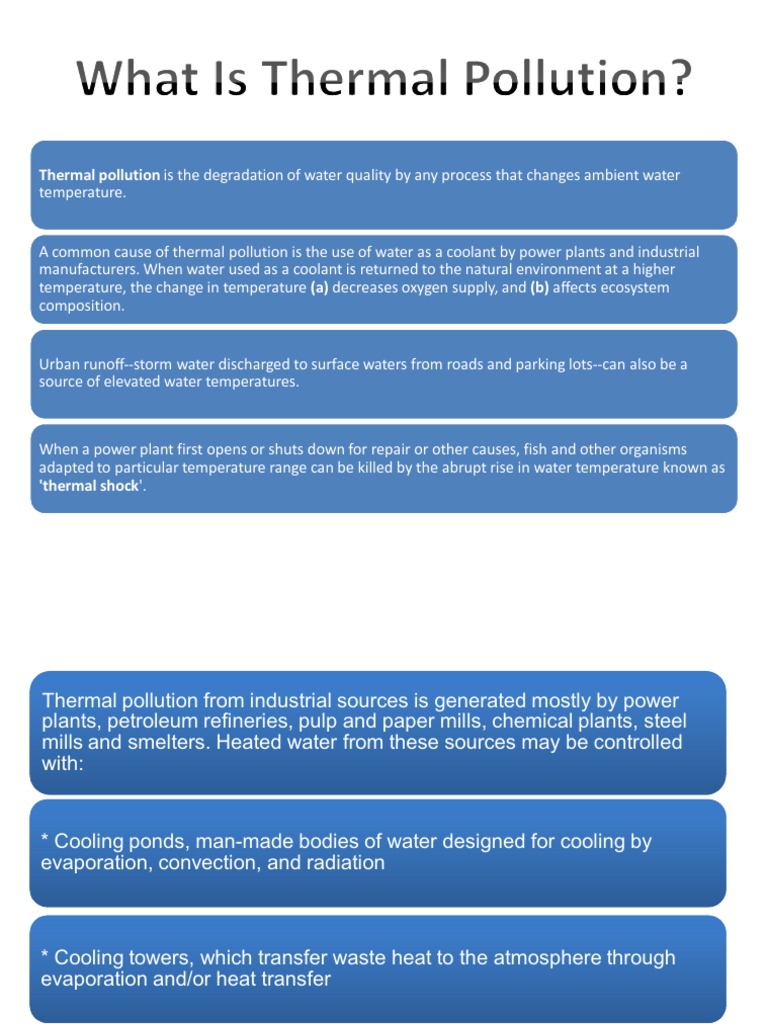Views
20,806

From Embeds
The geothermal heat flow. Such thermal pollution contributes to global warming until the global temperature has reached a level where this heat is also emitted to space. Heat dissipation from the global use of fossil fuels and nuclear power is the main source of thermal pollution.
Number of Embeds
 Actions
ActionsDownloads
Thermal Pollution Causes And Effects
Comments
Likes

Thermal Pollution In Water
Embeds 0
Itis caused by either dumping hot water from factories and power plants or removing trees and vegetation that shade streams, permitting sunlight to raise the temperature of these waters.Like other forms of water pollution, thermal pollution is widespread, affecting many lakes and vast numbers of streams and rivers in the United States and other parts of the world.Urban runoff–storm water discharged to surface waters from roads and parking lots–can also be a source of elevated water temperatures.Left unshaded, the water warms by as much as 10 Celsius degrees (18 Fahrenheit degrees). In a similar manner, grazing sheep and cattle can strip streamsides of low vegetation, including young trees. Muddy water absorbs more energy from the sun than clear water does, resulting in further heating. Finally, water running off of artificial surfaces, such as streets, parking lots, and roofs, is warmer than water running off vegetated land and, thus, contributes to thermal pollution.When water in an area warms more than they can tolerate, species that cannot move, such as rooted plants and shellfish, will die. Species that can move, such as fish, will leave the area in search of cooler conditions, and they will die if they can not find them.An increased metabolic rate may result in fewer resources; the more adapted organisms moving in may have an advantage over organisms that are not used to the warmer temperature. As a result, food chains of the old and new environments may be compromised. Some fish species will avoid stream segments or coastal areas adjacent to a thermal discharge. Biodiversity can be decreased as a result.the bacteria that decompose their dead tissue use up oxygen, further reducing the amount available for animals. The dead and decaying algae make the water look, taste, and smell unpleasant.This can cause an algae bloom which reduces oxygen levels.These cellular level effects can adversely affect mortality and reproduction.A large increase in temperature can lead to the denaturing of life-supporting enzymes by breaking down hydrogen- and disulphide bonds within the quaternary structure of the enzymes. Decreased enzyme activity in aquatic organisms can cause problems such as the inability to break down lipids, which leads to malnutrition.In a process called cogeneration, the excess heat energy from generating electricity can be used in another manufacturing process that needs such energy. Where homes or other buildings are located near industrial plants, waste hot water can be used for heating—an arrangement often found in Scandinavian towns and cities, and proposed for use in China.In a process called cogeneration, the excess heat energy from generating electricity can be used in another manufacturing process that needs such energy. Where homes or other buildings are located near industrial plants, waste hot water can be used for heating—an arrangement often found in Scandinavian towns and cities, and proposed for use in China.Regulations focus on a few of the most important threats. Grazing management plans, for instance, are intended to counter thermal pollution and other problems on lands owned by the federal government. In the United States, regulations governing logging on both public and private lands supposedly protect streamsides, though enforcement is often lax. Elsewhere, streamside protection is largely up to private landowners, encouraged and aided by such advisory organizations as the federal Natural Resources Conservation Service and cooperative Resource Conservation Districts. (saken galling to.. Ako n bhalamagexplainniyan.. =D)Landowners can leave strips of trees and vegetation along streams and shorelines. Grazing livestock can be kept away from streamsides by fencing.

 Actions
Actions